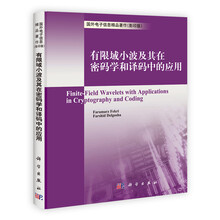有限域小波及其在密码学和译码中的应用(影印版)/国外电子信息精品著作

目 录内容简介
Preface
Figures
Tables
Algorithms
Acronyms
1 Introduction and Some Algebra Preliminaries
1.1 Notatio
1.1.1 Set Notation
1.1.2 Matrix Notation
1.1.3 Asymptotic Notation
1.1.4 General Notation
1.2 Abstract Algebraic Background
1.2.1 Group
1.2.2 Ring
1.2.3 Field
1.2.4 Irreducible and Primitive Polynomials
1.2.5 Co truction of Exte ion Fields
1.2.6 Module
1.2.7 Algebra
1.3 Linear Algebra Background
1.3.1 Involution
1.3.2 Sesquilinear Form
1.3.3 Unitary Matrix
1.3.4 Paraunitary Matrix
I Finite-Field Wavelets
2 Background Review and Motivation
2.1 Wavelets for Discrete-Time Signals
2.2 Cyclic Wavelet Tra forms
2.3 Review of Tra forms over Finite Fields
2.3.1 Discrete Fourier Tra form over Finite Fields
2.3.2 Base-Field Tra forms over Finite Fields
2.3.3 Related Work on Finite-Field Wavelets
3 Finite-Field Wavelet Basis Functio
3.1 Finite-Field Discrete-Time Basis
3.1.1 Non-Degenerate Bilinear Form
3.1.2 Orthonormal Wavelet Basis over Finite Fields
3.1.3 Completeness of the Orthonormal Set
3.2 Co truction of Mother Wavelet and Scaling Function
3.3 Summary
4 Theory of Paraunitary Filter Banks over Fields of Characteristic 2
4.1 Background Review
4.1.1 Degree-1 Paraunitary Building Block over GF(2)
4.1.2 Degree-2 Paraunitary Building Blocks over GF(2)
4.1.3 Lapped Orthogonal Tra forms over G F(2)
4.2 Unitary Matrices over GF(2r)
4.3 Paraunitary Matrices over Fields of Characteristic 2
4.3.1 Properties of 2 x 2 Paraunitary Matrices over GF (2r)
4.4 Factorization of Paraunitary Matrices over GF (2r)
4.4.1 Degree-1 Paraunitary Building Block over GF (2r)
4.4.2 Degree-2 Paraunitary Building Block over GF (2r)
4.4.3 Degree-2r Paraunitary Building Block over GF (2r)
4.4.4 Factorization of 2 x 2 Paraunitary Matrices over GF (2r)
4.4.5 Degree-Mr Paraunitary Building Block over GF (2r)
4.4.6 Factorization ofM x M Paraunitary Matrices over GF (2r)
4.5 Summary
II Multivariate Cryptography
5 Introduction
5.1 Historical Background and Motivation
5.2 RSA
5.3 Elliptic Curve Cryptography
5.4 Multivariate Cryptography
6 Wavelet Self-Synchronizing Stream Cipher
6.1 Background Review
6.1.1 Classification of Stream Ciphe
6.2 Wavelet Self-Synchronizing Stream Cipher (WSSC)
6.2.1 Modified Wavelet Tra form
6.2.2 Basic Round of the WSSC
6.2.3 Multiple Rounds of the WSSC
6.2.4 Key Setup
6.3 Cryptanalysis of the WSSC
6.3.1 Interpolation Attack
6.3.2 Algebraic Attacks
6.3.3 Delta Attack
6.3.4 Time-Memory Tradeoff Attack
6.3.5 Divide-and-Conquer Attack
6.3.6 Correlation and Distinguishing Attacks
6.4 Performance Evaluation
6.5 Summary
7 Wavelet Block Cipher
7.1 Background Review
7.1.1 Feistel Cipher and Data Encryption Standard (DES)
7.1.2 Advanced Encryption Standard (AES)
7.2 Wavelet Block Cipher (WBC)
7.2.1 Linear Components of the WBC
7.2.2 Nonlinear Components of the WBC
7.3 Two-Round Wavelet Block Cipher
7.3.1 Key Setup
7.4 Cryptanalysis of the WBC
7.4.1 Differential and Linear Attacks
7.4.2 Divide-and-Conquer Attack
7.4.3 Interpolation Attack
7.4.4 Delta Attack
7.5 Performance Evaluation
7.6 Summary
8 Paraunitary Public-Key Cryptography
8.1 Background Review
8.1.1 Signature Based on Birational Permutatio
8.1.2 Tame Tra formation Methods
8.1.3 Tractable Rational Map Cryptosystem
8.1.4 C* Algorithm and its Variants
8.2 Paraunitary Asymmetric Cryptosystem (PAC)
8.2.1 Bijective Mappings
8.2.2 Polynomial Vector
8.2.3 Setup Algorithms
8.3 Probabilistic PAC
8.4 On the Computational Security of the PAC
8.5 A Practical I tance of the PAC
8.5.1 Co tructing the Polynomial Vector
8.5.2 Complexity of the PAC
8.6 Cryptanalysis of the I tance of the PAC
8.6.1 Grobner Basis
8.6.2 Univariate Polynomial Representation of the Public Polynomials
8.6.3 XL and FXL Algorithms
8.6.4 An Attack for Small r
8.7 Paraunitary Digital Signature Scheme (PDSS)
8.7.1 Polynomial Vector
8.7.2 Setup Algorithm
8.7.3 A Practical I tance of the PDSS
8.8 Summary
III Error-Control Coding
9 Some Basic Concepts of Error-Control Coding
10 Double-Circulant Wavelet Block Codes
10.1 Structure of Double-Circulant Wavelet Coding
10.1.1 Wavelet Structures for Encoding and Decoding
10.2 Maximum-Distance Separable Codes
10.3 Double-Circulant Self-Dual Codes
10.3.1 Fundamental Structure of Self-Dual Wavelet Codes
10.3.2 Maximum-Distance Separable Self-Dual Codes
10.4 Decoding Wavelet Codes
10.4.1 Bounded-Distance Decoding of (20, 10, 6) Double-Circulant Wavelet Code
10.4.2 Bounded-Distance Decoding of the Wavelet-Golay Code
10.5 Summary
11 Arbitrary-Rate Wavelet Block Codes
11.1 Structure of Wavelet Coding
11.1.1 Wavelet Structure for Encoding and Decoding
11.2 Rate-1/L Maximum-Distance Separable Codes
11.3 Arbitrary-Rate Wavelet Block Codes
11.4 Arbitrary-Rate Maximum-Distance Separable Codes
11.5 Decoding Arbitrary-Rate Wavelet Block Codes
11.5.1 Bounded-Distance Decoding of the (12, 4, 6) Wavelet Code
11.5.2 Symbol Error Correction in the (7, 3, 5) MDS Code
11.5.3 Tail-Biting Trellises for Wavelet Block Codes
11.6 Summary
12 Wavelet Convolutional Codes
12.1 Structure of Wavelet Convolutional Codes
12.2 Algebraic Properties of Wavelet Convolutional Encode
12.3 Syndrome Generato and Dual Encode
12.4 Self-Dual and Self-Orthogonal Convolutional Codes
12.5 Time-Varying Wavelet Convolutional Codes and Bipartite Trellises
12.6 Summary
Appendices
A Proofs of Chap.4 in Part I
B Efficient Generation of PU Matrices
C Toy Examples of the PAC and the PDSS
D Proofs of Chap.10 in Part III
E Brief Review of Trellis Structures
Bibliography
Index
Figures
Tables
Algorithms
Acronyms
1 Introduction and Some Algebra Preliminaries
1.1 Notatio
1.1.1 Set Notation
1.1.2 Matrix Notation
1.1.3 Asymptotic Notation
1.1.4 General Notation
1.2 Abstract Algebraic Background
1.2.1 Group
1.2.2 Ring
1.2.3 Field
1.2.4 Irreducible and Primitive Polynomials
1.2.5 Co truction of Exte ion Fields
1.2.6 Module
1.2.7 Algebra
1.3 Linear Algebra Background
1.3.1 Involution
1.3.2 Sesquilinear Form
1.3.3 Unitary Matrix
1.3.4 Paraunitary Matrix
I Finite-Field Wavelets
2 Background Review and Motivation
2.1 Wavelets for Discrete-Time Signals
2.2 Cyclic Wavelet Tra forms
2.3 Review of Tra forms over Finite Fields
2.3.1 Discrete Fourier Tra form over Finite Fields
2.3.2 Base-Field Tra forms over Finite Fields
2.3.3 Related Work on Finite-Field Wavelets
3 Finite-Field Wavelet Basis Functio
3.1 Finite-Field Discrete-Time Basis
3.1.1 Non-Degenerate Bilinear Form
3.1.2 Orthonormal Wavelet Basis over Finite Fields
3.1.3 Completeness of the Orthonormal Set
3.2 Co truction of Mother Wavelet and Scaling Function
3.3 Summary
4 Theory of Paraunitary Filter Banks over Fields of Characteristic 2
4.1 Background Review
4.1.1 Degree-1 Paraunitary Building Block over GF(2)
4.1.2 Degree-2 Paraunitary Building Blocks over GF(2)
4.1.3 Lapped Orthogonal Tra forms over G F(2)
4.2 Unitary Matrices over GF(2r)
4.3 Paraunitary Matrices over Fields of Characteristic 2
4.3.1 Properties of 2 x 2 Paraunitary Matrices over GF (2r)
4.4 Factorization of Paraunitary Matrices over GF (2r)
4.4.1 Degree-1 Paraunitary Building Block over GF (2r)
4.4.2 Degree-2 Paraunitary Building Block over GF (2r)
4.4.3 Degree-2r Paraunitary Building Block over GF (2r)
4.4.4 Factorization of 2 x 2 Paraunitary Matrices over GF (2r)
4.4.5 Degree-Mr Paraunitary Building Block over GF (2r)
4.4.6 Factorization ofM x M Paraunitary Matrices over GF (2r)
4.5 Summary
II Multivariate Cryptography
5 Introduction
5.1 Historical Background and Motivation
5.2 RSA
5.3 Elliptic Curve Cryptography
5.4 Multivariate Cryptography
6 Wavelet Self-Synchronizing Stream Cipher
6.1 Background Review
6.1.1 Classification of Stream Ciphe
6.2 Wavelet Self-Synchronizing Stream Cipher (WSSC)
6.2.1 Modified Wavelet Tra form
6.2.2 Basic Round of the WSSC
6.2.3 Multiple Rounds of the WSSC
6.2.4 Key Setup
6.3 Cryptanalysis of the WSSC
6.3.1 Interpolation Attack
6.3.2 Algebraic Attacks
6.3.3 Delta Attack
6.3.4 Time-Memory Tradeoff Attack
6.3.5 Divide-and-Conquer Attack
6.3.6 Correlation and Distinguishing Attacks
6.4 Performance Evaluation
6.5 Summary
7 Wavelet Block Cipher
7.1 Background Review
7.1.1 Feistel Cipher and Data Encryption Standard (DES)
7.1.2 Advanced Encryption Standard (AES)
7.2 Wavelet Block Cipher (WBC)
7.2.1 Linear Components of the WBC
7.2.2 Nonlinear Components of the WBC
7.3 Two-Round Wavelet Block Cipher
7.3.1 Key Setup
7.4 Cryptanalysis of the WBC
7.4.1 Differential and Linear Attacks
7.4.2 Divide-and-Conquer Attack
7.4.3 Interpolation Attack
7.4.4 Delta Attack
7.5 Performance Evaluation
7.6 Summary
8 Paraunitary Public-Key Cryptography
8.1 Background Review
8.1.1 Signature Based on Birational Permutatio
8.1.2 Tame Tra formation Methods
8.1.3 Tractable Rational Map Cryptosystem
8.1.4 C* Algorithm and its Variants
8.2 Paraunitary Asymmetric Cryptosystem (PAC)
8.2.1 Bijective Mappings
8.2.2 Polynomial Vector
8.2.3 Setup Algorithms
8.3 Probabilistic PAC
8.4 On the Computational Security of the PAC
8.5 A Practical I tance of the PAC
8.5.1 Co tructing the Polynomial Vector
8.5.2 Complexity of the PAC
8.6 Cryptanalysis of the I tance of the PAC
8.6.1 Grobner Basis
8.6.2 Univariate Polynomial Representation of the Public Polynomials
8.6.3 XL and FXL Algorithms
8.6.4 An Attack for Small r
8.7 Paraunitary Digital Signature Scheme (PDSS)
8.7.1 Polynomial Vector
8.7.2 Setup Algorithm
8.7.3 A Practical I tance of the PDSS
8.8 Summary
III Error-Control Coding
9 Some Basic Concepts of Error-Control Coding
10 Double-Circulant Wavelet Block Codes
10.1 Structure of Double-Circulant Wavelet Coding
10.1.1 Wavelet Structures for Encoding and Decoding
10.2 Maximum-Distance Separable Codes
10.3 Double-Circulant Self-Dual Codes
10.3.1 Fundamental Structure of Self-Dual Wavelet Codes
10.3.2 Maximum-Distance Separable Self-Dual Codes
10.4 Decoding Wavelet Codes
10.4.1 Bounded-Distance Decoding of (20, 10, 6) Double-Circulant Wavelet Code
10.4.2 Bounded-Distance Decoding of the Wavelet-Golay Code
10.5 Summary
11 Arbitrary-Rate Wavelet Block Codes
11.1 Structure of Wavelet Coding
11.1.1 Wavelet Structure for Encoding and Decoding
11.2 Rate-1/L Maximum-Distance Separable Codes
11.3 Arbitrary-Rate Wavelet Block Codes
11.4 Arbitrary-Rate Maximum-Distance Separable Codes
11.5 Decoding Arbitrary-Rate Wavelet Block Codes
11.5.1 Bounded-Distance Decoding of the (12, 4, 6) Wavelet Code
11.5.2 Symbol Error Correction in the (7, 3, 5) MDS Code
11.5.3 Tail-Biting Trellises for Wavelet Block Codes
11.6 Summary
12 Wavelet Convolutional Codes
12.1 Structure of Wavelet Convolutional Codes
12.2 Algebraic Properties of Wavelet Convolutional Encode
12.3 Syndrome Generato and Dual Encode
12.4 Self-Dual and Self-Orthogonal Convolutional Codes
12.5 Time-Varying Wavelet Convolutional Codes and Bipartite Trellises
12.6 Summary
Appendices
A Proofs of Chap.4 in Part I
B Efficient Generation of PU Matrices
C Toy Examples of the PAC and the PDSS
D Proofs of Chap.10 in Part III
E Brief Review of Trellis Structures
Bibliography
Index
目 录内容简介
《有限域小波及其在密码学和译码中的应用(影印版)》探讨了有限域小波与滤波器组理论,开创了“有限域小波变换理论”,此理论提出了一个定义在有限域上的一般的小波分解序列。《有限域小波及其在密码学和译码中的应用(影印版)》还介绍了此理论在纠错代码和数据安全性上的首次应用。《有限域小波及其在密码学和译码中的应用(影印版)》可作为应用数学、密码学、差错控制编码领域研究者的参考书,对于从事密码项目开发的实际工作者也有很大的价值。
比价列表
公众号、微信群
 缺书网
缺书网微信公众号
 扫码进群
扫码进群实时获取购书优惠






